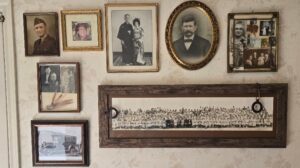If you say “dumb as a mule” you’re not very smart. If you say “strong as a mule” you may be closer to intelligence. If you say “smart as a mule” you know about mules and what you’re talking about.
Stuart Hart of rural Creek County deals in automobiles.
But he also knows about another piece of transportation — one that’s been around much longer, and to some folk’s way of thinking is 10 times more dependable and more economical than today’s car, truck or tractor, hybrid or otherwise. We’re talking about the lowly mule.
Hart raises the hybrid animal at his farm southwest of Sapulpa not so much for transportation but for the same reasons breeders before him have done so — to perform certain tasks seemingly better than other modes.
“Stubborn? Not really,” says Hart. “That’s a bum rap.” Mules may come across as stubborn, he says but the reason a mule may be hesitant to do certain things is because (unlike humans) mules are smart enough to not want to do things that “hurt” themselves (other team members or their human counterparts). Mules aren’t willing to overwork themselves the same way horses do or take unnecessary risks.
A mule is the offspring of a male donkey (jack) and a female horse (mare). Horses and donkeys are different species, with different numbers of chromosomes. Of the two F1 hybrids (first generation hybrids) between these two species, a mule is easier to obtain than a hinny, which is the offspring of a female donkey (jenny) and a male horse (stallion).
Mules are reputed to be more patient, hearty and long-lived than horses, and are described as less obstinate and more intelligent than donkeys.
Mules, like horses, communicate with their bodies. When a mule perks both ears forward, his attention is keenly focused on something before him. Both ears pinned back, means a violent reaction can be expected, most likely a bite or kick.
“A mule can kick you if it wants to,” Hart said. “And they are very curious. You can be carrying something and they will come to check it out.” And they can climb . . . about anything they want.
Ears out to the side, like airplane wings, means the mule is seriously thinking about something.
Listing other differences from a horse, Hart said a mule can scratch its own belly with its hind foot. Unlike a horse, a mule’s tail is a small, skimpy fly swatter. They never carry their (sometimes shaved) tails high and proud, like a horse does. When angry, a mule will “ring” his tail — swing it in a circle many times.
Hart doesn’t use his mules to get back and forth to town. Cars and pickups are better for that. Hart will sell you one of those. He’s less likely to part with his mules. He has a half dozen now and is making new ones on a regular basis. About one a year. Foals are carried by their horse mothers about 11 months (340 days) and can be male or female — jacks or mollies. And yes, mature mules will breed, but only in very rare “once in a blue moon” will reproduce.
Parents for a mule are chosen based on the offsprings’ intended purposes — packing, pulling, riding or (yesteryear) for picking cotton — kept small so the human cotton picker didn’t have to stand up to put cotton in the sack. The mother horse determines the mule’s size, the length of its stride, his jumping ability and his physical endurance. A mule’s intelligence, easy care, sure-footedness and longevity are credited to his donkey father. The size depends largely on the breeding of the mule’s female parent (dam). Mules can be lightweight, medium weight, or when produced from draft horse mares, of moderately heavy weight.
Hart takes a lot of pleasure in his mules. He and his family as well as their friends utilize the animal for things like hunting, pleasure riding, packing game out of the woods and cowboy rodeo events at the Harts’ cowboy-themed church, Faith Baptist, nearby. They have even outfitted Pastor Steve Lambertson with his own mule. Needless to say, mules get just as much respect as horses in the roping and riding cowboy events.
Hart has been breeding mules more than a dozen years. His wife Jan is a partner in his mule interest, as are two grown sons and their families. They and friends join them on camping and hunting trips. There are five couples that regulary make up the Hart entourage. The mules ride along in horse trailer styled campers.
The adventures can be intense when they include local white tail deer and wild hog hunts, or big horn sheep and elk hunts in Wyoming and Colorado; and extensive when such Hart excursions ride their mules through the Needle (Black Hills) and tie up “across the road” while they visit the faces of Mount Rushmore. In times past they would have rented horses for such events. Taking your own mules with you adds to the adventure.
If Hart were to price his mules for sale they would sell for $3,000 to $10,000. That’s the norm, however, some will bring upwards of $60,000. Hart stays abreast of such things when he goes to mule auctions each year including the big one at Columbia, Boone County, Missouri (this writer’s old stomping grounds).
There’s a popular annual mule sale in Ada, Okla. Ears, feet, and width of withers (the highest part of the back, lying at the base of the neck above the shoulders. The height of a horse is measured to the withers so many hands high.) Those things plus demand determine the price. Hart’s stock — red, black, mixed are ideally 15.1 hands tall.
Sugar and draft mules are the same height, about eighteen hands. But, the sugar mule is lighter in weight, about 1,150 pounds. The draft mule weighs in at about 1,300 pounds — the largest and heaviest mule breed. A prime draft mule example is the famous Death Valley Twenty Mule Team from the nineteenth century, and 1950s television featuring mule teams that hauled soap-making materials from the Mojave Desert.
Nor does Hart use his mules to plow with or for other farm shores as so many early Oklahomans did. He could (but does not) team the mules up to pull wagons, carts or carriages. He basically rides them.
“You can do anything on a mule — rodeo, race, jump and even some things horses can’t do,” says Hart who also raises and likes horses. He runs his breeding mare with the mules. One writer suggests that is a good plan since most mares otherwise would be scared to death of the “weird jackass” and would never normally mate with one.
Hart uses Wilkinson Farriers of Bristow (cousins) to shoe his mules. Any business that caters to horse people will also take care of mule people — no stubbornness,
Neighbor David Bacon also has mules. Dub Enlow also is known to hitch and utilize mules. In fact, as folks drive around the Creek County countryside, they may be surprised at how many mules they can find if they’re watching out for those long ears, short tails, and an expression on that long face that says “hey, you’re looking at one smart cookie.”










